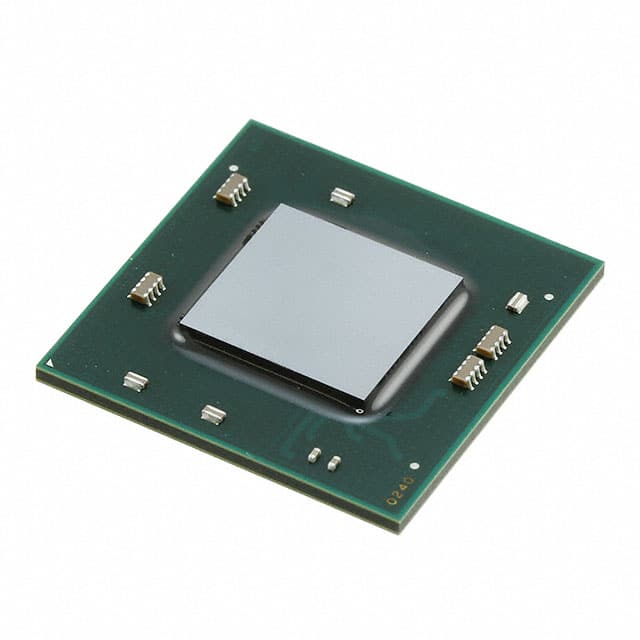Xem thông số kỹ thuật để biết chi tiết sản phẩm.

XC7Z030-L2SBG485I
Product Overview
Category
The XC7Z030-L2SBG485I belongs to the category of programmable system-on-chip (SoC) devices.
Use
This product is primarily used in applications that require high-performance processing and programmable logic capabilities.
Characteristics
- High-performance processing: The XC7Z030-L2SBG485I is equipped with a powerful dual-core ARM Cortex-A9 processor, enabling efficient execution of complex tasks.
- Programmable logic: It features a field-programmable gate array (FPGA), allowing users to customize the device's functionality according to their specific requirements.
- Integrated peripherals: The SoC includes various peripherals such as USB ports, Ethernet interfaces, and memory controllers, enhancing its versatility for different applications.
Package
The XC7Z030-L2SBG485I comes in a BGA (Ball Grid Array) package, which provides excellent electrical performance and mechanical stability.
Essence
At its core, this product combines the benefits of a high-performance processor and a programmable logic device, offering a versatile solution for demanding applications.
Packaging/Quantity
The XC7Z030-L2SBG485I is typically packaged individually and is available in various quantities depending on the customer's needs.
Specifications
- Processor: Dual-core ARM Cortex-A9
- FPGA Logic Cells: 154K
- Memory: 512MB DDR3
- Clock Frequency: Up to 1 GHz
- Operating Voltage: 1.0V
- I/O Interfaces: USB, Ethernet, SPI, I2C, UART, etc.
- Operating Temperature Range: -40°C to 100°C
Detailed Pin Configuration
For a detailed pin configuration diagram of the XC7Z030-L2SBG485I, please refer to the manufacturer's datasheet.
Functional Features
- High-performance processing: The dual-core ARM Cortex-A9 processor enables efficient execution of complex algorithms and tasks.
- Programmable logic: The integrated FPGA allows users to implement custom logic functions, enabling flexibility and adaptability.
- Versatile peripherals: The SoC includes various interfaces and controllers, facilitating seamless integration with external devices.
- Low power consumption: The XC7Z030-L2SBG485I is designed to optimize power efficiency, making it suitable for battery-powered applications.
Advantages and Disadvantages
Advantages
- Powerful processing capabilities
- Customizable logic functionality
- Versatile peripheral integration
- Low power consumption
Disadvantages
- Relatively high cost compared to traditional microcontrollers
- Steeper learning curve for programming and utilizing the FPGA features
Working Principles
The XC7Z030-L2SBG485I combines the processing power of the ARM Cortex-A9 cores with the flexibility of the integrated FPGA. The ARM cores handle general-purpose computing tasks, while the FPGA can be programmed to implement custom logic functions. This combination allows for efficient and adaptable processing in a wide range of applications.
Detailed Application Field Plans
The XC7Z030-L2SBG485I finds application in various fields, including but not limited to: 1. Industrial automation: It can be used for real-time control systems, data acquisition, and communication interfaces. 2. Communications: The device's processing power and programmable logic make it suitable for networking equipment, base stations, and protocol conversion applications. 3. Medical devices: Its versatility allows for implementation in medical imaging, patient monitoring, and diagnostic equipment. 4. Aerospace and defense: The XC7Z030-L2SBG485I can be utilized in radar systems, avionics, and secure communication systems.
Detailed and Complete Alternative Models
- XC7Z020-L2SBG485I: Similar to the XC7Z030-L2SBG485I, but with a lower FPGA logic cell count.
- XC7Z045-L2SBG485I: Offers higher FPGA logic cell count for more complex applications.
- XC7Z100-L2SBG485I: Provides increased processing power and FPGA resources compared to the XC7Z030-L2SBG485I.
These alternative models offer varying levels of performance and functionality, allowing users to choose the most suitable option for their specific requirements.
Note: The content provided above is an example and may not reflect actual product specifications or details.
Liệt kê 10 câu hỏi và câu trả lời thường gặp liên quan đến ứng dụng XC7Z030-L2SBG485I trong giải pháp kỹ thuật
Sure! Here are 10 common questions and answers related to the application of XC7Z030-L2SBG485I in technical solutions:
Q: What is XC7Z030-L2SBG485I? A: XC7Z030-L2SBG485I is a System-on-Chip (SoC) device from Xilinx, which combines a dual-core ARM Cortex-A9 processor with programmable logic.
Q: What are the key features of XC7Z030-L2SBG485I? A: The key features include a high-performance FPGA fabric, integrated peripherals, DDR3 memory controller, Ethernet MACs, USB ports, and multiple serial interfaces.
Q: What are the typical applications of XC7Z030-L2SBG485I? A: XC7Z030-L2SBG485I is commonly used in applications such as industrial automation, automotive electronics, medical devices, aerospace systems, and high-performance computing.
Q: Can XC7Z030-L2SBG485I be programmed using Xilinx's Vivado software? A: Yes, XC7Z030-L2SBG485I can be programmed using Xilinx's Vivado Design Suite, which provides a comprehensive development environment for FPGA designs.
Q: Does XC7Z030-L2SBG485I support real-time operating systems (RTOS)? A: Yes, XC7Z030-L2SBG485I supports various RTOS options like FreeRTOS, VxWorks, and QNX, allowing developers to build real-time applications.
Q: What is the power consumption of XC7Z030-L2SBG485I? A: The power consumption of XC7Z030-L2SBG485I depends on the specific configuration and usage scenario. It is recommended to refer to the datasheet for detailed power specifications.
Q: Can XC7Z030-L2SBG485I interface with external devices? A: Yes, XC7Z030-L2SBG485I supports various interfaces like SPI, I2C, UART, CAN, and GPIOs, enabling communication with a wide range of external devices.
Q: Is XC7Z030-L2SBG485I suitable for high-speed data processing applications? A: Yes, XC7Z030-L2SBG485I's FPGA fabric and high-performance ARM Cortex-A9 cores make it well-suited for high-speed data processing tasks.
Q: Are there any development boards available for XC7Z030-L2SBG485I? A: Yes, Xilinx offers development boards like Zynq-7000 SoC ZC702 Evaluation Kit, which can be used for prototyping and evaluation of XC7Z030-L2SBG485I-based designs.
Q: Where can I find technical documentation and support for XC7Z030-L2SBG485I? A: Technical documentation, including datasheets, user guides, and application notes, can be found on Xilinx's official website. Xilinx also provides customer support through their online forums and direct contact channels.

